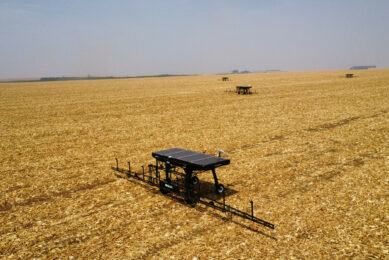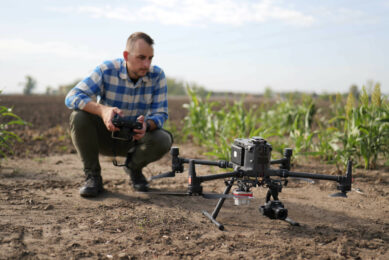Beginner’s guide to agricultural drones

Drones are becoming increasingly important in agriculture and more and more farmers are considering purchasing a drone. But how do you get started? Dr. Jason de Koff explains the basics of agricultural drones.
Unmanned aerial vehicles (UAVs), also known as drones, can play an important and useful role in a farmer’s daily life. The greatest advantage comes from the time that can be saved in scouting fields or animals without all of the driving around or footwork.
In crop production, drones can pinpoint trouble areas in the field that wouldn’t be found by the normal observer while in animal production, they can be used to check on animals and water sources or fencerows.
Fixed wing drone and multi-rotor drone
These aircraft come in two main varieties, the fixed wing and the multi-rotor drone. Fixed wing drones can usually cover more area in less time because they fly faster and have a longer battery life while multi-rotor drones are usually cheaper and can be easier to maneuver.
A typical fixed wing drone can fly for about one hour and cover around 500 to 900 acres while a multi-rotor drone has a flight time of 30 to 40 minutes and may only cover 100 to 200 acres.
Text continues underneath images
Some examples of companies that produce fixed wing drones include SenseFly and PrecisionHawk while those that sell multi-rotor drones include DJI and Parrot. A drone that can be used in professional farming applications can cost anywhere around $ 400 to $ 7,500. There are definitely ways to spend more than this but most of these other drones or add-ons aren’t needed in an agricultural setting.
Sensors
Sensors can be paired with drones to provide additional information but are usually expensive and can range around $ 2,000 to $ 10,000 depending upon the number of sensors incorporated and the type of sensors purchased. In general, however, the information you get from the camera that comes with the drone can be just as useful.
Software subscriptions
There are third party software subscriptions that can be purchased which use the images captured from the camera and create maps that can provide crop information like plant health and plant population. These kinds of subscriptions can range from $ 30 to $ 250 per month and some examples of these include DroneDeploy, FieldAgent, PrecisionAnalytics, and Pix4DFields.
Each one comes with a free trial period so a producer can identify which software works best for them. Some of these software can even create zone maps which, when paired with farm equipment that uses GPS technology, can help apply variable rates of pesticides or fertiliser across a field.
Text continues underneath images
FAA certification
In the U.S., the Federal Aviation Administration (FAA) requires anyone flying a drone that weighs 0.55 to 55 lbs, and using it for commercial or educational purposes, to be certified as a remote pilot. This includes farmers since they will be using drones to make decisions on the farm.
A certification requires passing a written exam (60 multiple choice questions) with 70% or more correct. The testing costs $ 160 and must be performed at an official FAA testing facility.
The exam includes topics about drone regulations, airport operations, the physics of flight, weather, physiological factors, risk assessment, and reading aeronautical (sectional) charts. Once achieved, a remote pilot certification needs to be renewed every 2 years. Also, if a drone is within the weight class identified above, it must be registered, regardless of the application the drone will be used for. Registration costs $ 5 and is available through the FAA Drone Zone website and is good for 3 years.
Text continues underneath images
Drone research
Drones have multiple uses on the farm from checking crops and animals to assessing damage. There is much research currently being done to identify ways to use drones in other applications such as weed and disease identification, water and nutrient deficiencies, yield determinations, and pesticide application.
As the technology continues to improve and these aircraft become more widely used and available, they are likely to become an important addition to any farmer’s toolkit.
Also read: Drone spraying takes off as regulations relax worldwide
Join 17,000+ subscribers
Subscribe to our newsletter to stay updated about all the need-to-know content in the agricultural sector, two times a week.



